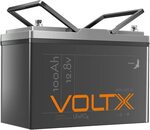Not the best battery in the market but for the price it’s decent which comes with 3 year warranty.
Copied from Voltx website :
SPECIFICATIONS
Nominal Capacity: 100Ah
Usable Capacity: 100Ah
Nominal Voltage: 12.8V
Energy: 1280Wh
Charge Voltage: 14.2-14.6V
Discharge Cut-off Voltage: 10V
Charge Method: CC/CV
Charger: 14.6V 20A
Standard Charge Current: 50A
Max Charge Current: 50A
Standard Disharge Current: 50A
Max Continues Discharge Current: 50A
Max Discharge Current 5 sec: 100A
Life Cycle: Approx. 2000 Cycles
Working Temperature Range: Charge: 0°C to 45°C
Discharge: -20°C to 50°C
Storage Temperature: -10°C to 50°C
Battery Cells: Prismatic
Bolt Type: Hexagon
Bolt Material: Iron nickel-plated
Series Connection: No
Parallel Connection: No
Warranty: 3 years
DIMENSIONS & WEIGHT
Bolt Terminal Size (Length): M8 x 12mm
Bolt Terminal Perimeter: 25.12mm
Dimensions: 306(L) x 169(W) x 215(H)mm
Weight: 14.2kgs
Get quality power at an affordable price. The VoltX 12V 100Ah Lithium Battery LiFEPO4 provides real capacity and unrivalled efficiency in a compact, lightweight form. Delivering top-notch performance that all VoltX batteries are known for, this lithium battery is great for both camping days and as backup power in case of power outages.
VoltX lithium batteries are all supported by prismatic cells coupled with a built-in Battery Management System. Why is this important? Aside from maintenance-free usage, their thin profile allows for a battery that is significantly smaller than conventional power packs, which is advantageous in any outdoor or RV setting.
Smaller doesn't mean weaker when it comes to VoltX, though. All of our batteries boast a long lifespan and impressive cycles. This particular 12V 100Ah lithium battery lasts for up to 7 years with 2,000 cycles. It's a practical choice for any outdoor lover, plus the array of advanced features including a new and improved design adds to its already excellent form.
Bask in the beauty of the outdoors while enjoying maximum comfort. Experience the VoltX quality now and power up wherever your adventure takes you!




 CamelCamelCamel
CamelCamelCamel

Only if i could figure out a way to use it on my electric bicycles. Tiny 10ah replacement battery costs double this price.